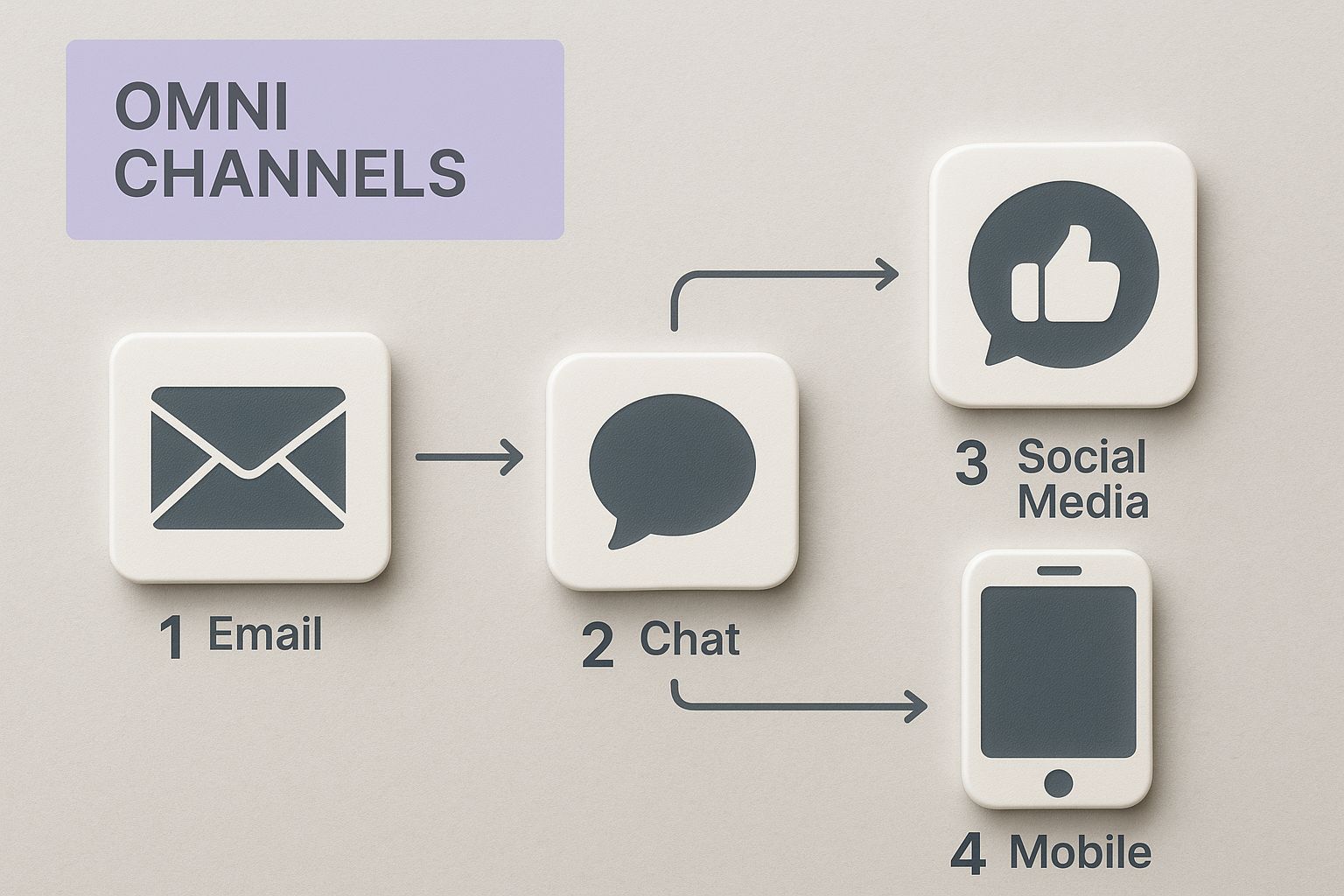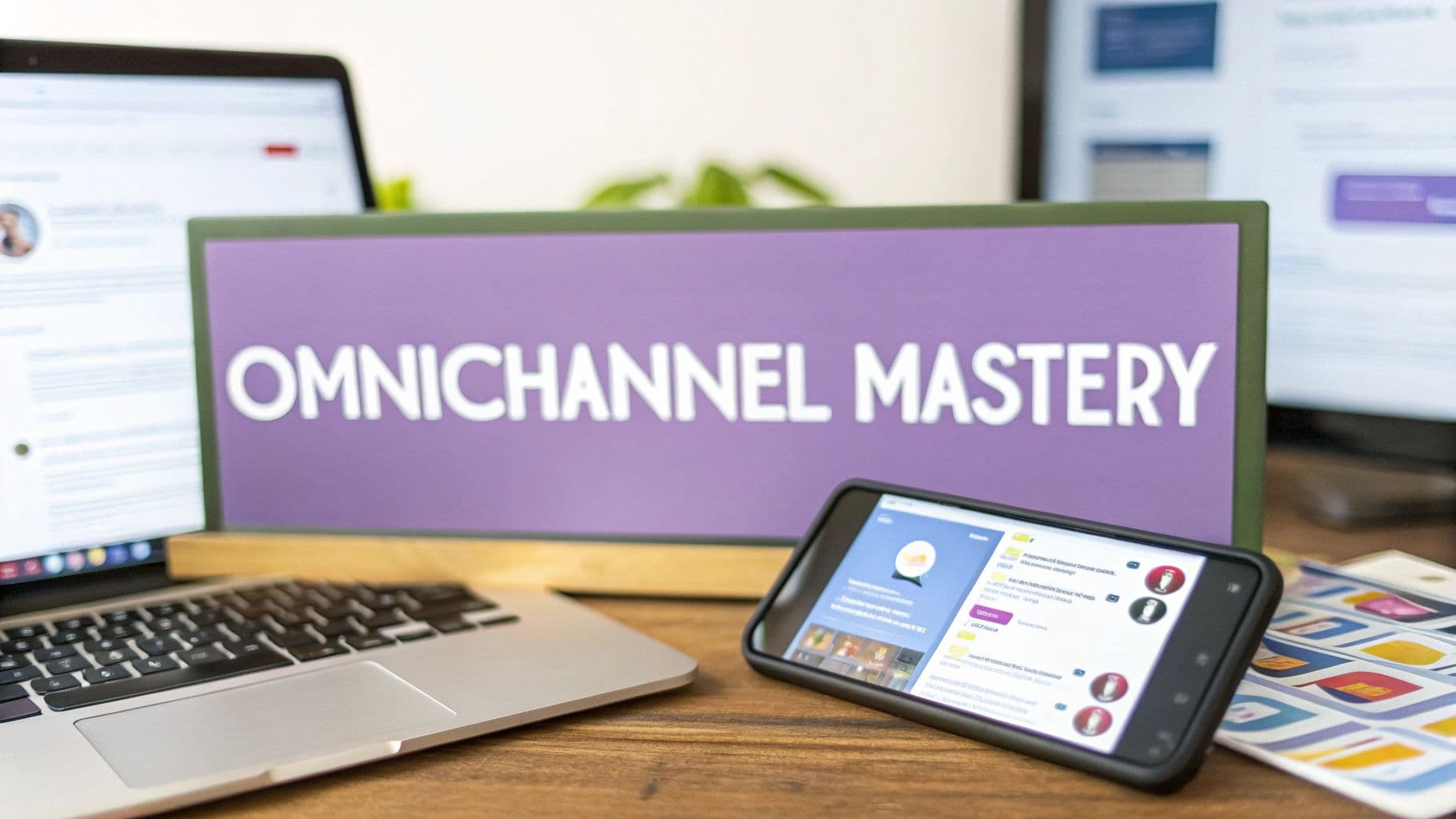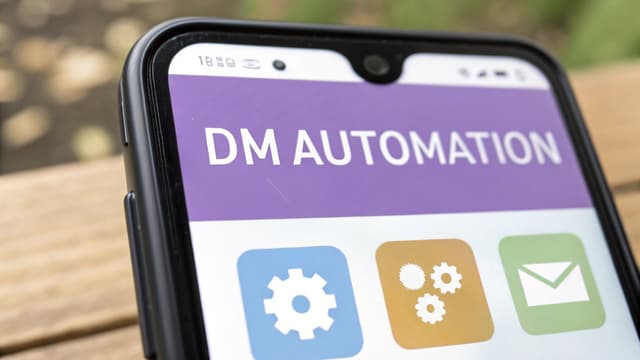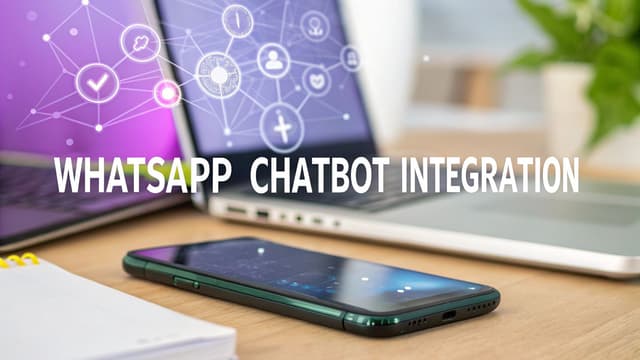Let's be honest, customers today expect to be able to talk to you anywhere, anytime, without having to repeat their life story. An omnichannel communication strategy is your answer to that expectation. It's about much more than just being present on Instagram, WhatsApp Channel, and your website; it's about weaving these channels into one intelligent, seamless conversation.
Why a Unified Communication Strategy Is Essential Now
The modern customer journey isn't a straight line. It zigs and zags across different digital touchpoints. A customer might see your ad on Instagram, slide into your DMs with a quick question, then switch to WhatsApp for more detailed info, and finally, head over to your website to make the purchase.
Without a unified strategy, that journey becomes a mess—fragmented, frustrating, and a huge turn-off.
This is exactly where an AI-powered omnichannel communication strategy steps in. The goal is to create one continuous, context-aware dialogue that's managed by a single intelligent AI. Each channel—Instagram, WhatsApp, and your website chat—simply becomes another door into the same ongoing conversation, not a brand-new, isolated interaction.
The Real Cost of a Disconnected Experience
When these channels operate in their own little silos, the customer is the one who pays the price. They're forced to re-introduce themselves and re-explain their problem every single time they switch platforms. That friction doesn't just damage the customer experience; it hits your bottom line, hard.
The numbers don't lie. Companies with strong omnichannel strategies retain an average of 89% of their customers. Compare that to just a 33% retention rate for businesses with weaker, siloed approaches. The difference is stark. It also translates directly to revenue, as shoppers who engage across multiple channels tend to contribute 30% more over their lifetime.
A true omnichannel approach ensures the conversation follows the customer, not the other way around. It remembers their history, understands their intent, and makes them feel known and valued, regardless of whether they're on your website or their favorite messaging app.
Moving Beyond Multichannel to True Omnichannel
It's really important to get the distinction here between multichannel and omnichannel. Having a chatbot on your site and separate automated replies on Instagram isn't an omnichannel strategy. That's just being available in multiple places. The magic happens when those channels are truly interconnected.
To make it crystal clear, let's break down the differences.
Omnichannel vs Multichannel Communication at a Glance
| Feature | Multichannel Communication | Omnichannel Communication |
|---|---|---|
| Customer Experience | Fragmented. Customers must repeat themselves on each new channel. | Seamless. The conversation follows the customer across all channels. |
| Data & Context | Siloed. Each channel operates independently with its own data. | Centralized. A single, unified profile tracks all customer interactions. |
| Business Operations | Disjointed. Teams and tools for each channel work separately. | Integrated. All channels are managed through a single, connected system. |
| The Core Idea | "We are available on many channels." | "We offer a single, unified experience across all channels." |
As you can see, multichannel is about presence, while omnichannel is about creating a truly integrated experience.
This level of integration is no longer a "nice-to-have" reserved for massive corporations. It’s a fundamental shift in customer expectations that businesses of all sizes must adapt to. However, to maximize the impact of your omnichannel efforts, it's crucial to align them within your overarching digital transformation roadmap. By implementing an AI that unifies your Instagram, WhatsApp, and website communications, you're not just improving service—you're building a rock-solid foundation for sustainable growth and real customer loyalty.
For a deeper look into this, our guide on omnichannel customer service offers additional insights. And if you're ready for a comprehensive look at implementation, this omnichannel contact center success guide is an excellent resource.
Auditing Your Current Customer Touchpoints

Before you can build that seamless experience you're dreaming of, you need a brutally honest look at where the cracks are in your current setup. A truly effective omnichannel communication strategy starts by understanding how customers interact with you right now across your key channels—Instagram, WhatsApp, and your own website.
This isn't about finding fault. It's about finding opportunities. The goal is to pinpoint every point of friction, every time a customer has to repeat themselves, and every dead end that forces them to start over. These are the exact disconnects your future AI-powered strategy is meant to fix.
Think of yourself as a detective investigating your own customer experience. You have to map the journey from their perspective to see exactly where the conversation breaks down. This grounds your strategy in real-world frustrations, not just abstract ideas.
Exposing the Silos in Your Channels
Let's start with a simple test. Send a basic question to your website's chatbot—something like, "What are your shipping options?" A day later, slide into your Instagram DMs and ask, "Can you track my order for me?" Finally, pop over to WhatsApp and message your business with, "I asked about this yesterday, any update?"
If your team (or your current automation) is completely blind to the previous interactions, you've just found a massive silo. Each channel is acting like its own isolated island, creating a choppy and frustrating experience for anyone trying to connect with you. This is a common reason why customer satisfaction scores take a nosedive.
To dig a little deeper, ask yourself these crucial questions about your current process:
- Conversation History: If a customer chats on our website today and DMs us on Instagram tomorrow, can our team see the full, unified history?
- Customer Recognition: Does a customer have to re-introduce themselves and their issue every single time they switch from WhatsApp to the website?
- Contextual Handoffs: When a query gets escalated from a chatbot to a human agent, does that agent get the entire transcript from all previous channels?
If you answered "no" to any of these, you've pinpointed a critical failure point. These are the exact problems a unified AI agent is built to solve.
Mapping the Customer's Communication Journey
Now, let's get even more specific by mapping out a few potential user scenarios. This isn't just a technical exercise; it's an empathy exercise. Put yourself in your customer's shoes and try to get something done.
Scenario Example: The Pre-Sale Inquiry
- Instagram: A potential customer spots a product in your latest post and sends a DM: "Do you have this in blue?"
- Website: They click the link in your bio and use the web chat for a more detailed question: "What's the return policy for sale items?"
- WhatsApp: Later that day, they're ready to buy. They message you on WhatsApp: "Hey, I'm ready to buy the blue shirt I asked about on IG. Can you confirm the final price with shipping?"
In a disconnected system, this journey is a complete headache. The customer has to repeat their interest in the blue shirt three different times. An omnichannel communication strategy ensures the AI knows it's the same person asking about the same product, creating a smooth and direct path to purchase.
By the end of this process, you'll have a clear, actionable list of problems to tackle. You'll go from a vague feeling that "things could be better" to a concrete understanding of what needs to be fixed. This audit becomes the blueprint for your AI implementation, ensuring you build a system that directly solves the most painful parts of your current customer experience.
Unifying Your Channels with AI
So, you've audited your setup and pinpointed the gaps in how you talk to customers. What's next? It's time to bridge those gaps with the right tech. This is where your omnichannel communication strategy really starts to take shape, powered by a single, smart AI that acts as the central brain for every customer conversation, whether it happens on Instagram, WhatsApp, or your website.
The concept is simple but incredibly powerful. Instead of juggling separate, siloed bots for each platform, you deploy one unified AI. This central intelligence connects to your Instagram DMs, the WhatsApp Business API, and your website's live chat, creating a truly seamless conversational experience for your customers.
This visual captures how all those different touchpoints can be woven together into one cohesive strategy.

As you can see, a modern strategy has to account for all the places your customers are and integrate them so information flows freely.
Choosing Your Unified AI Platform
The first real step is picking an AI platform built for this exact job. You're looking for a solution that can pull messages from Instagram, WhatsApp, and your website into one unified inbox. But it's more than just putting messages in one place; it's about giving the AI a single "memory" and context engine.
When you're looking at different platforms, here’s what you should zero in on:
- Native Integrations: Does it offer direct, easy-to-set-up connections for the Instagram API, the official WhatsApp Business API, and a website chat you can customize? Steer clear of any tool that relies on clunky, unofficial workarounds.
- Unified Customer Profiles: The system absolutely must recognize a customer as the same person, whether they DM you on Instagram or start a chat on your site. It needs to pull their entire history into one profile.
- Centralized Knowledge Base: You should only have to "teach" your AI once. A central knowledge base guarantees that the answers it gives are consistent, no matter if the question comes from WhatsApp or your website.
Tools like Salesforce CRM are often used to consolidate this kind of customer data, giving a powerful AI the rich context it needs to unify these channels effectively.
The Nuts and Bolts of API Integration
Getting these channels connected means working with APIs (Application Programming Interfaces). I know, that sounds technical. But modern AI platforms are designed to make this as painless as possible, often boiling it down to just a few clicks to authorize your accounts.
The platform will connect to Meta's backend to pull in your Instagram DMs and WhatsApp messages. At the same time, it will give you a little snippet of code to pop onto your website to get the web chat running. Once everything is linked, data starts flowing into your new central system. You’ve now created that critical single source of truth for every customer conversation.
This integration is the technical backbone of your omnichannel communication strategy. It’s what ensures that when a customer sends you a DM, the AI already knows about their past WhatsApp chats and website visits, and vice-versa.
A Real-World Omnichannel Scenario in Action
Let's walk through how this plays out for an e-commerce brand selling custom phone cases.
-
It Starts on Web Chat: A customer, "Alex," is on your website and has a question. He opens the web chat and asks the AI, "Can I use my own photo for a case, and will it be blurry?" The AI instantly confirms that custom photos are an option and explains the best image resolution to avoid any blurriness.
-
The Switch to WhatsApp: Hours later, Alex is on his phone with the perfect photo ready to go. He doesn't feel like navigating back to the website. He remembers the brand has a WhatsApp number and shoots over a message: "Hi, it's Alex. I was asking about a custom case earlier. Here is the photo, can you tell me if this will work?"
-
The Seamless Handover: Because you have a unified AI, it recognizes Alex's phone number and immediately connects it to his earlier web chat. The AI analyzes the image and replies right there on WhatsApp: "Thanks, Alex! I've checked the image. The resolution is perfect and won't be blurry. Would you like me to create a draft order for you?"
-
The Follow-Up on Instagram: The next day, after placing his order, Alex is scrolling Instagram and sees a new case design he loves. He slides into your DMs: "Hey! I just ordered a case yesterday, but saw this new design. Is it too late to change it?" Accessing his unified profile, the AI instantly pulls up his recent order and checks its status. It responds: "Hi Alex, I see your order #54321. It hasn't gone to print yet, so we can still change the design. Please confirm you'd like to switch to the 'Sunset' design."
This entire conversation—spanning three different channels—was handled by a single AI without ever losing context. Alex never had to repeat himself. The experience was fast, personal, and efficient. That’s the real power of a true omnichannel approach.
The future of customer service is undeniably moving toward this integrated model. The trend is clear: By 2025, adoption of AI in omnichannel communication is expected to be nearly universal, with 97% of businesses planning to use it. On top of that, generative AI is on track to handle up to 70% of all customer interactions without human help, which could boost customer satisfaction by a whopping 30%.
By unifying your key channels with a single AI brain, you stop just being present on multiple platforms and start creating intelligent, context-aware conversations that build real trust and loyalty.
Designing Your Cross-Channel Customer Journey
Okay, you've got your unified AI technology sorted. Now, let's shift from the technical setup to the part that really matters: designing the customer experience.
A smart omnichannel communication strategy isn't about just copying and pasting the same chatbot script across every channel. The real win comes from crafting conversations that feel completely natural on each platform, all while being part of a single, connected journey.
This means playing to the unique strengths of Instagram, WhatsApp, and your own website. Your AI needs to get the vibe of each one—understanding the different ways people talk and what they expect in each environment. You're not just repeating the same script; you're tailoring the delivery.
Crafting Platform-Native AI Conversations
Think of your AI as a master communicator who's fluent in the "language" of every channel. The core message and the customer's history stay consistent, but how it's delivered changes to fit the context perfectly.
For example, on Instagram, your bot can be more visual and casual. It might use more emojis and quick-reply buttons, which is ideal for engaging with story mentions or fielding quick product questions.
But on WhatsApp, the interaction can be more direct and to the point. It’s the perfect place for sending timely order updates with tracking links. Then on your website, the AI can really shine by using rich media like GIFs or even embedded videos to walk a customer through an interactive product demo.
This approach makes sure the conversation never feels clunky or out of place. The user gets an experience that feels right for the app they’re in, which is a massive boost for engagement and satisfaction.
Leveraging Unified Data for Hyper-Personalization
This is where your omnichannel communication strategy starts to feel like magic. Because your AI has a single, unified memory of every customer touchpoint, it can deliver incredibly personalized—and even proactive—support.
When a customer starts a chat, the AI doesn’t just see a new message. It sees their entire history. It knows about the products they were checking out on your website last week, the question they DM'd on Instagram yesterday, and the shipping notification they got on WhatsApp this morning.
This 360-degree view allows the AI to do some pretty amazing things:
- Anticipate Needs: Let's say a user was just browsing high-performance running shoes on your site. If they then message you on WhatsApp, the AI can skip the generic "how can I help?" and get straight to the point: "Hey! Looking for shoes for the road or for the trails?"
- Offer Relevant Solutions: A customer DMs on Instagram asking about their order. Instead of making them dig up an order number, the AI can instantly pull their recent purchase history and give a specific update.
- Create Seamless Transitions: The AI can pick up a conversation right where it left off, even on a different channel. It might say in a web chat, "I see you asked about our return policy on WhatsApp earlier. Here's a link with the full details, and I can start that return for you right here if you'd like."
This level of personalization makes customers feel like you actually get them. The goal is to shift from just reacting to problems to proactively helping them. If you want to really nail this, digging into the principles of customer journey orchestration is a great next step.
By designing conversations that are both platform-appropriate and context-aware, you transform your customer support from a simple function into a powerful brand differentiator. It’s the difference between just being available and being genuinely helpful.
Mapping the AI-Powered Journey
Getting this right takes some planning. You need to map out how conversations will flow across your channels and what role each one plays in the bigger picture.
Focusing on the right channels is key. Recent research shows that today's omnichannel strategies are heavily concentrated on a few platforms. Social media leads the pack, used by 66.7% of marketers, followed closely by mobile websites (58%) and desktop websites (52.7%). This tells us we absolutely have to meet customers where they already are.
Here’s what a journey map could look like for a retail brand:
Scenario: A Customer Interested in a New Product
| Channel | User Action | AI-Powered Response & Goal |
|---|---|---|
| Sees a new product in a post and sends a DM: "Is this available?" | The AI uses quick replies to confirm stock and guide to the website. Goal: Drive online traffic or answer quick questions. | |
| Website | Visits the site and uses the chatbot: "What materials is this made from?" | The AI provides detailed product specs, maybe with a short video. Goal: Answer detailed questions and build purchase confidence. |
| Adds the item to their cart but abandons it. | After an hour, the AI sends a WhatsApp message: "Hi! We noticed you left an item in your cart. Can I help answer any questions?" Goal: Recover the sale and offer final assistance. |
This kind of connected, multi-touchpoint approach makes your omnichannel communication strategy more than just a buzzword. It becomes a practical, revenue-driving system built around smart, personalized conversations.
How to Measure and Refine Your Strategy

Getting your AI-powered omnichannel communication strategy live is a fantastic milestone, but it's really just the starting line. I’ve seen too many businesses celebrate the launch and then forget the most important part. Real, lasting success comes from treating your strategy like a living, breathing system—one that needs constant attention, measurement, and fine-tuning.
Your goal here is to get past the surface-level vanity metrics. Honestly, who cares how many total messages your AI sends? That number doesn’t tell you if customers are actually happy, if their problems are getting solved, or if this whole thing is making a dent in your bottom line.
Instead, we need to dig into the analytics that your AI platform provides. The data you collect isn't just a report card; it's your roadmap to making continuous improvements and getting a much better return on your investment.
Defining Your Core Omnichannel KPIs
To get a true read on performance, you need to track metrics that tell a story across your entire communication ecosystem—from your website chat to Instagram DMs and WhatsApp conversations. A solid AI platform should pull all this data together, giving you one clean, unified view of what your customers are experiencing.
Here are the essential KPIs I always tell people to watch:
- Unified Customer Satisfaction (CSAT): Don't just poll customers on your website. A true omnichannel CSAT score gathers feedback from every single interaction, whether it wrapped up on Instagram or started on WhatsApp. This gives you a complete, holistic picture of customer sentiment.
- True First Contact Resolution (FCR): A customer's "first contact" isn't always a single channel anymore. It might start on Instagram and finish on WhatsApp. True FCR tracks whether the AI solved their problem within that one continuous conversation, no matter how many times they hopped between channels.
- Customer Effort Score (CES): How hard is it for customers to get what they need? By measuring CES across your channels, you can quickly spot points of friction. If you see a high effort score on Instagram DMs, for example, it’s a big red flag that you need to adjust your conversational flows there.
- Containment Rate: This is a big one. It measures how many conversations your AI handles successfully from start to finish, without ever needing to pass it off to a human. A steadily climbing containment rate is a powerful sign that your AI is getting smarter and more efficient.
These metrics paint a much richer and more actionable picture than just counting messages. They show you whether your AI is genuinely making customers' lives easier. To create the best possible journey, you have to maintain a consistent customer experience across channels—a core principle that these KPIs help you measure and enforce.
Using Data to Spot Friction and Optimize Flows
Think of your AI's analytics dashboard as a treasure map. It’s where you’ll spot patterns in how people interact, find the common roadblocks tripping them up, and uncover opportunities to make your conversational flows feel more intuitive and intelligent.
Keep an eye out for trends like high drop-off rates at certain points in a conversation. For instance, if you notice lots of people on your website chat give up when the AI asks for an order number, maybe you can tweak the flow. You could train the AI to try identifying them by their email address first—a much lower-friction approach.
A powerful technique I recommend is to constantly A/B test different conversational paths. You could try out two different opening greetings on WhatsApp—one that's very direct and another that's more casual—to see which one gets a better engagement rate. These small, data-driven tweaks can lead to huge improvements in the user experience over time.
Likewise, digging into your "not understood" queries is like getting free consulting. If your Instagram users are constantly asking about a new product your AI knows nothing about, that’s your cue to update its knowledge base immediately.
This cycle of analyzing, testing, and refining is what separates a good strategy from a great one. It’s how you ensure your omnichannel communication strategy evolves to consistently meet—and even exceed—what your customers expect.
Common Questions We Hear About Implementation
Even the most carefully planned omnichannel communication strategy will spark a few practical questions once you start connecting the dots. As you bring your website chat, Instagram DMs, and WhatsApp conversations into one place, you’ll naturally run into some common hurdles. It's smart to think about these now to build a stronger system from day one.
Let’s tackle a few of the big ones.
"Do I Really Need a Different AI for Each Channel?"
This is one of the first questions people ask, and it gets right to the core of what omnichannel is all about. The answer is a hard no. In fact, running separate bots would completely undermine the entire strategy.
A true omnichannel communication strategy isn’t just about being present on multiple channels; it’s about unifying them. This requires a single, unified AI platform that acts as the central brain for your website, Instagram, and WhatsApp.
Think of it this way: your AI is the command center. It listens for messages on every channel and replies through the right one. This unified setup is the only way to share conversation history and customer data seamlessly. It gives your AI the full picture, no matter where the customer decides to talk to you next.
Using different bots for each channel is a classic multichannel mistake, not an omnichannel solution. It creates the very communication silos you're trying to break down and forces customers to repeat themselves—a guaranteed way to frustrate them.
"How Does the AI Know When to Hand Off to a Human?"
Look, no AI can solve 100% of customer problems. Sometimes, you just need a person. A smooth, invisible handoff from your chatbot to a human agent is what separates a good experience from a great one, especially for complex or sensitive issues.
Any good omnichannel platform has this escalation process baked in. Your AI isn't just answering questions; it's also listening for cues that demand a human touch.
You can train your AI to recognize specific triggers, like:
- Customer sentiment: Is the person getting frustrated, angry, or confused? The AI should pick up on that.
- Keyword triggers: Simple phrases like "speak to a human," "I need an agent," or "file a complaint" are clear signals.
- Query complexity: When a question goes beyond its programming or requires a level of judgment the AI doesn't have, it's time to escalate.
When a handoff is triggered, the platform should instantly transfer the entire conversation history—from that first Instagram DM to the latest website chat message—to a human agent's inbox. This gives your team immediate context, so they can jump in and solve the problem without making the customer start all over again.
"Can I Keep My Brand Voice Consistent Everywhere?"
Absolutely. Consistency is everything when it comes to building trust and a brand people recognize. Your central AI platform is actually the key to making this happen, not a barrier.
You’ll establish your core brand personality, define its tone, and build a single knowledge base from one central dashboard. That becomes the single source of truth for every interaction.
From there, you can—and should—tweak the delivery slightly to feel native to each platform.
- Instagram: Keep it more casual. Use quick replies and emojis to match the vibe. For details on screenshot notifications, check out Instagram screenshot notifications explained.
- WhatsApp: Be more direct and helpful, perfect for quick order updates or support answers.
- Website Chat: Go more in-depth. This is the place for rich media, product demos, or detailed explanations.
Even with these stylistic tweaks, the core information and personality come from the same place. So whether a customer DMs you on Instagram or opens a chat on your site, they always feel like they're talking to the same helpful, reliable brand.
Ready to deploy a single AI agent that unifies your customer conversations and delivers a seamless experience? FlowGent AI provides a no-code platform to launch intelligent assistants across WhatsApp, Instagram, and your website, ensuring every interaction is context-aware and perfectly on-brand. Learn more and start building your intelligent agent.


